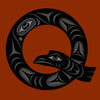Chavín Culture Spatula, c. 1200-200 B.C.
Regular price
$1,500.00
Sale
Northern Peru
Bone
7 1/4" high x 1 1/2" wide x 5/8" deep
10" high x 2" wide x 2" deep (on stand)
Ancient spatula from the Chavín culture of northern Peru, 1200 to 400 B.C. This ornate bone implement was used to inhale hallucinogenic powders. Decorated with images of two musicians at the base. Above is a shaman blowing a shell horn back to back with a mythical serpent.
The Chavín culture represents the first widespread, recognizable artistic style in the Andes. Chavín art can be divided into two phases: The first phase corresponding to the construction of the "Old Temple" at Chavín de Huántar (1200–500 B.C.); and the second phase corresponding to the construction of Chavín de Huántar's "New Temple" (500–200 B.C.).
Chavín art is known for its complex iconography and its "mythical realism". There is constant evidence within all types of art (ceramics, pottery, sculptures, etc.) of human-animal interactions, which was reflective of societal interconnections and how the Chavín people viewed themselves connected with "the other world".
Some other iconography found in Chavín art continues to give a glimpse as to what the culture was like, such as the general evidence of the use of psycho-active plants in ritual. The San Pedro Cactus is often seen on various art forms, sometimes being held by humans, which is used as evidence to support the use of the plant





